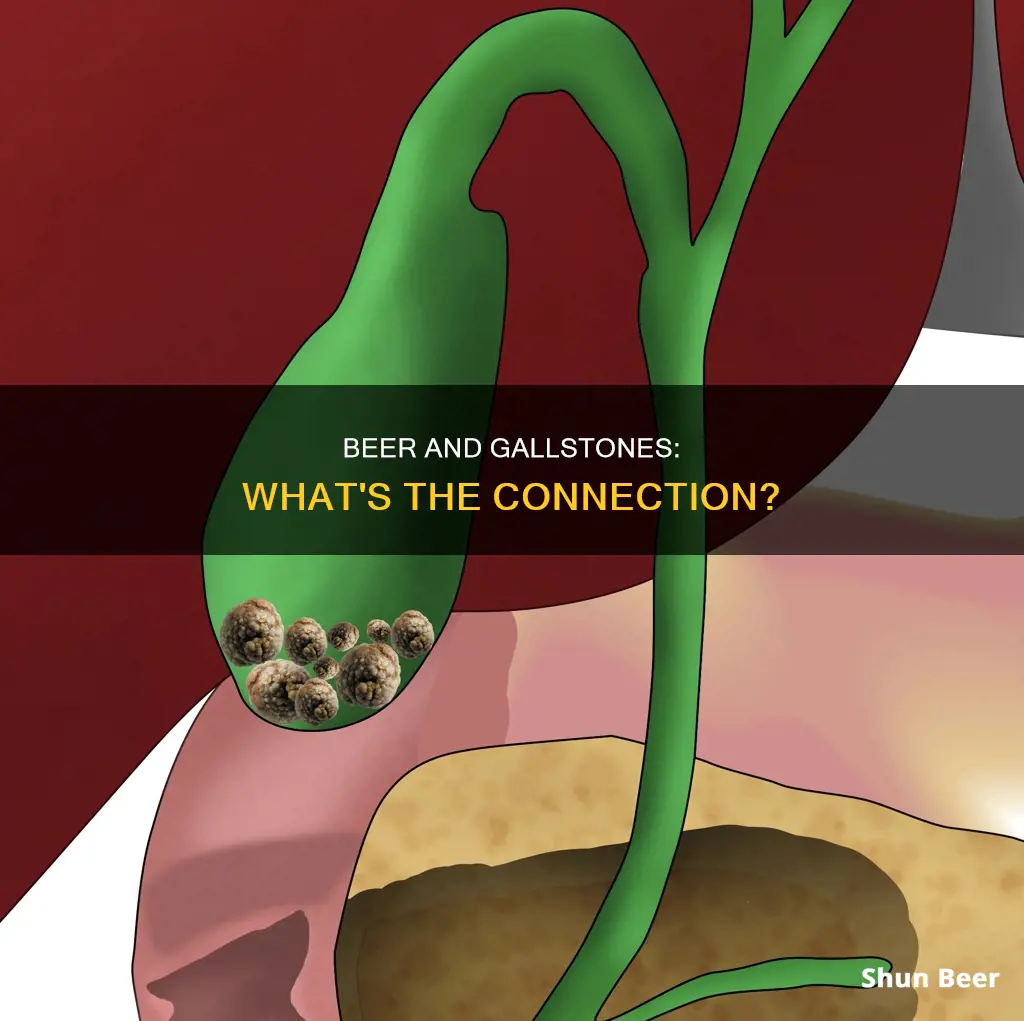
Alcohol consumption has been linked to a reduced risk of gallstones, but this relationship is complex and not fully understood. While some studies suggest that moderate alcohol intake may lower the risk of gallstone formation, others indicate that alcohol may slow the gallbladder's functioning. Heavy drinking can also lead to cirrhosis, which is a risk factor for gallstones. Therefore, while small to moderate amounts of alcohol may reduce the risk of gallstones, excessive drinking can indirectly contribute to their formation.
| Characteristics | Values |
|---|---|
| Can alcohol cause gallstones? | There is no evidence to indicate that alcohol can cause gallstones. |
| Can alcohol prevent gallstones? | Research suggests that moderate alcohol consumption may reduce the risk of gallstones. |
| Is alcohol bad for gallbladder health? | Heavy drinking can indirectly cause gallstones and exacerbate existing gallstone symptoms. |
| Is binge drinking bad for gallbladder health? | Binge drinking can lead to gallbladder problems and pain. |
What You'll Learn
- Research suggests that moderate alcohol consumption may reduce the risk of gallstones
- Heavy drinking can lead to cirrhosis, which increases the risk of gallstones
- Binge drinking is defined as more than four drinks in two hours for women and five drinks for men
- Heavy drinking is defined as four drinks per night or 14 drinks per week for men, and three drinks per night or seven drinks per week for women
- Alcohol intolerance is common after gallbladder removal

Research suggests that moderate alcohol consumption may reduce the risk of gallstones
Another theory relates to cholesterol, which is often a component of gallstones. It is possible that alcohol consumption may lead to lower cholesterol levels in bile, thereby reducing the risk of gallstone formation.
According to a 2019 review of 24 studies, moderate alcohol consumption may be linked to a lower risk of gallstones. However, the review's authors mention that this trend depends on daily consumption of less than 28 grams of alcohol on average. In addition, while moderate alcohol consumption may reduce the risk of gallstones, heavy drinking is linked to an increased risk of gallbladder cancer.
Drinking Beer in Vondelpark: What You Need to Know
You may want to see also

Heavy drinking can lead to cirrhosis, which increases the risk of gallstones
Heavy drinking can have a detrimental impact on your health in many ways. One of the most common disorders of the gallbladder is the formation of gallstones, which are made from cholesterol and bile that has hardened. While alcohol does not directly cause gallstones, heavy drinking can indirectly contribute to their formation through liver cirrhosis, a serious condition linked to drinking.
Cirrhosis is a condition in which the liver gradually slows down and eventually stops working. People with cirrhosis are more likely to experience gallstones. About a third of people with cirrhosis get gallstones, often due to complications from liver scarring.
Research suggests that moderate alcohol consumption may lower the risk of gallstones in some people. However, heavy drinking can increase the risk of developing cirrhosis, which in turn increases the risk of gallstones. Therefore, it is important to drink in moderation or abstain from alcohol completely to maintain good health.
If you are experiencing any symptoms of gallstones or liver problems, it is best to consult a healthcare professional. They can provide guidance and treatment options to help manage your condition.
Old Beer: Is It Safe to Drink After Two Months?
You may want to see also

Binge drinking is defined as more than four drinks in two hours for women and five drinks for men
Binge drinking is a pattern of drinking that brings blood alcohol concentration (BAC) to 0.08% or more. This typically happens when a woman consumes four or more drinks or a man consumes five or more drinks within about two hours. Binge drinking is defined as drinking a large amount of alcohol in a short time, with the intention of becoming intoxicated. This drinking pattern is more common in males, adolescents, and young adults.
Binge drinking is associated with adverse health effects, including neurologic, cardiac, gastrointestinal, and immune disorders. It also increases the risk of alcohol-induced psychiatric disorders and several types of cancer. Binge drinking during adolescence is linked to a higher probability of developing alcoholism in adulthood. It is also associated with a higher risk of accidents, violent behaviour, and suicide attempts.
Binge drinking can lead to brain damage and cognitive impairments. It affects impulse control, particularly in women, and is linked to an increased risk of unprotected sex, unplanned pregnancies, and sexual assault. It is also associated with spousal abuse, poor job performance, and divorce.
Binge drinking has negative effects on metabolism, lipid profile, blood coagulation, and vascular tone. It increases the risk of cardiovascular problems, embolic stroke, and acute myocardial infarction. It is also linked to ketoacidosis, bladder rupture, and alcohol poisoning.
Binge drinking is considered harmful at any age, and healthcare professionals generally recommend consuming little to no alcohol.
Beer and Breastfeeding: What's Safe?
You may want to see also

Heavy drinking is defined as four drinks per night or 14 drinks per week for men, and three drinks per night or seven drinks per week for women
Heavy drinking is defined as consuming four or more drinks on any given day or 14 or more drinks per week for men, and three or more drinks on any given day or seven or more drinks per week for women. Binge drinking and heavy drinking are two distinct types of excessive alcohol consumption. Binge drinking is defined as consuming a large quantity of alcohol in a short period, with the specific number of drinks varying by gender. According to the National Institute on Alcohol Abuse and Alcoholism (NIAAA), binge drinking is defined as having a blood alcohol concentration (BAC) of 0.08% or higher. This typically occurs when a woman consumes four or more drinks or a man consumes five or more drinks in about two hours.
Heavy drinking includes binge drinking and is defined by the NIAAA as consuming four or more drinks on any day or eight or more per week for women, and five or more drinks on any day or 15 or more per week for men. This pattern of drinking significantly increases the likelihood of alcohol use disorder (AUD) and other alcohol-related harms.
While moderate alcohol consumption may lower the risk of gallstones, heavy drinking can have various negative effects on the body. It is important to note that healthcare professionals generally recommend consuming little to no alcohol, as alcohol intake is associated with an increased risk of certain medical conditions.
Beer and Gabapentin: Safe Mix or Health Risk?
You may want to see also

Alcohol intolerance is common after gallbladder removal
Alcohol intolerance is a common issue for people who have had their gallbladder removed. The gallbladder is a small organ that sits just under the liver and stores bile, which is crucial for fat digestion. When the gallbladder is removed, the body can still produce bile and digest fats, but the amount of bile excreted is directly proportional to the amount of food eaten. This means that without a gallbladder, the body cannot collect bile for future use, and the small bile ducts that remain try to compensate for excretion.
When alcohol is introduced to the body, it causes these ducts to contract, further compromising bile flow. This can lead to symptoms such as gas, bloating, or diarrhea. Additionally, alcohol can also play a role in the development of pancreatitis, as it has a similar effect on the pancreatic ducts. For this reason, hard liquor is strictly forbidden during the initial rehabilitation period after gallbladder removal surgery, which can last from one month to at least one year. Many health experts recommend lifelong abstinence from alcohol to be safe.
It is important to note that the gallbladder does not play a direct role in alcohol metabolism. However, moderate alcohol consumption has been linked to a lower risk of gallstone formation. This is believed to be related to alcohol's ability to lower cholesterol levels, although the exact mechanism is not yet fully understood. Nevertheless, excessive alcohol consumption can have various negative effects on the body, including the development of cirrhosis and an increased risk of several types of cancer. Therefore, it is generally recommended to consume little to no alcohol.
Beer and Eliquis: Safe Mix?
You may want to see also







